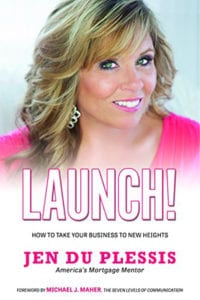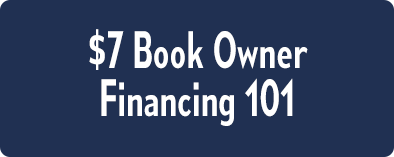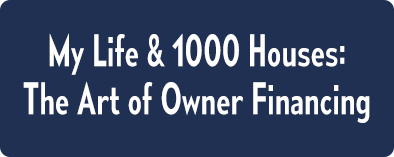PODCAST
From Part Time To Full Time with Jen Du Plessis
Episode 307: From Part Time To Full Time with Jen Du Plessis

Humans as we are, we outgrow so many things in our lives, most especially our jobs. The longer we are with it, the less it seems to accommodate us not only financially but emotionally as well. If you are thinking of taking that next step and starting your own business, let Jen Du Plessis of Kinetic Spark Consulting push you in the right direction. With a 35-year career in mortgage lending helping investors through multiple challenges, Jen takes you through the process from being in a part-time job to a full-time business. As she highlights the common mistakes many new entrepreneurs make, she gives advice on how to properly go around creating a business of your own. Taking on a new venture can be daunting, but with good preparation on hand, you’ll be able to build the business and life you want.
—
Watch the episode here:
I have Jen Du Plessis on the show. Many people go out in the world and have a full-time job or a career, but they’re trying to break out and become their own person. It’s difficult to manage the time, figure out what to do first so that you can work your way out into a new life, leave the one that you’ve been doing for ten, fifteen or twenty years and work your way into a new life where you’re your own business. It’s difficult for anyone. I had both things going for a long time. I had to burn the candle at both ends. You can burn out pretty fast. If you don’t make some headway, you can get discouraged real fast. We’re going to be talking to Jen Du Plessis about how to overcome that challenge to take the next step in your life. Jen, how are you doing?
I’m doing great.
You have a 35-year career in mortgage lending where you took great pride in not just doing the easy, simple FHA and conventional loans. You also helped all the investors with their wrap mortgages and trying to find the money for their rental houses and all that, some of the more challenging stuff. Tell us more about your history.
First of all, thank you so much for having me on the show. I’m so excited to be here and share as much content as we possibly can, as much value in the time that we have together. I left a 35-year career. My degree is in architectural design and construction engineering. Somehow, I got into mortgages. Nobody goes to school for that. I wish people did because they would learn more about finances. I spent 35 years top in the country. One of my niches was investors. My entire family is investors. I got bored after a while and said, “There’s got to be more for me than the typical 30-year fixed rate loan for a client who’s looking to buy a house.” Because my niche was investing, I always had people come to me and say, “Do you know anybody who can do a more private second mortgage? Do you have any hard moneylenders? Do you have any other sources?” I did a lot of research. Part of it came to fruition because I too had gone beyond the traditional financing. I couldn’t get traditional financing. I had to find outlets and sources for myself as well. That’s where that came up. I started going, “There’s a whole world out here of fix and flip, buy and holds, wrap mortgages, lease options and tax liens. There are all kinds of things that I could be tapping into in helping investors grow their wealth.” That was what it was. It’s how I could help them get better at growing their wealth and realizing their legacy and dynasty.
That’s one of the things I’m fond of are wrap mortgages. We’ll buy about 120 houses in 2019. I use all private money to do that. We’ll seller finance about 80 of those 120 houses.
That’s my primary way of buying. I used to buy and hold traditional financing and then later gain capital. When I had enough capital, I would buy another one. I stumbled upon wrap mortgages a few years ago and that’s all I’ve been doing ever since. I love helping people because it’s the buyer on the one side. You’re also helping the seller, but it’s also the buyer too getting them into a home.
There’s a third person you’re helping. I’m doing all this with private money. There are a lot of retired people who are sick and tired of making 1% or 2% at the bank and gambling in the stock market, not knowing if they’re going to make anything, when they can spend it or when to get in or get out. Here I am offering them 6% to 8% with a real piece of real estate behind it. For some people, it’s neither here nor there. For a lot of people who didn’t have a lot of savings, maybe they in their entire life they managed to save $400,000 to $600,000. It’s an income between 1% and 2%. 8% is a huge difference in their life.
Even now, the stock market had another high. We’re coming up to the point where when we have this trend that we’re looking at finding a recession here soon and rates are going to drop, which means rates drop in your bank account.
People tell me all the time, “I make a lot better than 8% of the stock market.” “Have you taken your money out?” They said, “No.” I said, “Then you haven’t made anything. Talk to me when you pull it out.” When you pull it out, it’s critical.
It’s like a margin.
Don’t chop off one job and start a new job. Build a bridge between the two. Share on XLet’s say we have these people out there. There are hundreds of thousands of them at least. They’re dreaming of a better life. They have a job and doing okay. Maybe they’re not even doing okay. You outgrow your job. The longer you’re with it, the less your job seems to accommodate you emotionally and financially, in most cases. Instead of begging for pay raises or hoping for pay raises, one of the things to do is go out and start your own business. If you pick the right business and you’re dedicated and get educated enough, maybe that business replaces your job and more. The sky is the limit for you. Who’s the average person who’s coming to you and saying, “Help me?”
They’re small entrepreneurs, solopreneurs, people who are doing exactly what you’re saying. They’ve had a career and they say, “It’s time to go to another line of business.” Small businesses make up almost 90% of all businesses in the country. It’s crazy, but they don’t survive. That’s the problem. They rarely make it through a year. Those that make it past five years are the ones who are going to be successful. Don’t chop off one job and start a new job. Build a bridge between the two. It’s like a holding strategy. You’re in a holding strategy with your job but build an exit strategy for your position and not just cut it off and go someplace. That’s one of the things that I hear so many people doing. They’re just saying, “I’d had it. I threw up the towel. I decided that I was going to become a solopreneur,” but they don’t have the skills in business to be a solopreneur. They may not have the skills that are required, which is all marketing, sales and branding. If they don’t have those skills and they fail, that’s the worst thing in the world.
They start chasing all these shiny objects that they see like all these cool ways to make money. “Maybe I’ll sell stuff on Amazon or eBay. Maybe I’ll be an investor.” Teachers, after teaching 35 years, want to be out. Military people want to be out after 35 years. I’m from Colorado Springs, Colorado originally. It’s a big military area. You want to be out. After 35 years of lending, I wanted something more that would give me a challenge. I knew that I couldn’t cut off $700,000 to $800,000 income and go to zero. That’s not possible. If I did that, it would suck up all the savings that I ever did. I’m using that as an example. Because I was in lending, I bought my own product. That’s one of the things that drives me crazy about real estate agents. Most of them don’t own real estate. It’s like being a Mary Kay Consultant and saying, “You should buy Mary Kay and have makeup,” but I don’t wear makeup.
One of the times I laughed the hardest was when I was with my partner. We were with the biggest best foreclosure attorney in town. We went over to his office to get him to take over our foreclosure needs. We asked him, “How many properties do you own? You’re in the foreclosure business. You must find all kinds of deals all the time.” His answer was, “I wouldn’t touch this stuff. It’s too litigious.” I said, “Would you please just tell me about the ones that you think are good?” He says, “I don’t think any of them are any good.” This guy is sick.
We find so many people who are like that. What my husband and I started doing is we started accumulating properties over the years. We bought our first home when we were nineteen before we got married. We don’t have anymore. We sold it. We started accumulating homes over the period. I had that residual income, that mailbox income coming in from my buy and holds, but I wanted more. I had to learn how to do these wraps. That’s why I started doing them a few years ago. It was part of my exit strategy because I retired from lending. I learned in running one of the top producers in the entire United States. I had to find time to learn how to run a business on the side so I can build that bridge and have that freedom that I was always hoping for and not being tied to the job but being able to be tied to my lifestyle.

Starting Your Own Business: The biggest mistake early entrepreneurs make is hiding behind all of the busyness of the business and not forging forward.
This is what Jen wants to help people do. That is to make that bridge between your current life and the life and business that you’re trying to build. A giveaway for our readers is the 7 Strategies to Jump-Start Your Business. It’s a reset. If you’ve been out there already trying to do this, it’s a way to refocus, bring in these seven steps, start to reanalyze what you’ve been doing against these seven steps and see if there are some adjustments to make. It’s so that you can keep progressing in your side endeavor or side gig until it puts your job on a business.
It’s your exit strategy. You’re growing that bridge to exit wherever you’re at. If you’re not in business and you’re already saying, “I want to be an investor so I already quit my job. I want to be a solopreneur and I already quit my job,” but you’re struggling, this is what those seven steps will do too. You’ll say, “Let me regroup and see where I stand and where I need to go to be successful.” A lot of people don’t possess that business mentality, that entrepreneurship mentality in a typical job.
Everything is a lot more personal. When you’re placing ads for your company, you just got to place the ad. When you’re placing ads for your company, it’s like, “These ads cost $150 a whack. In my house, we’re tight.” You can’t be tight in certain things when you’re in business. You can’t be penny smart and dollar dumb. You’ve got to spend some money sometimes and take a chance. There are ways to do that stuff. What is one of the number one mistakes people make? What’s the number one thing they need help with but they’re not even aware that they need help with it?
When you have a job, you go to your job every day whether you like it or not. You have to go. When you become an entrepreneur, you don’t have to go but you still have to have that mentality of doing things you don’t like to do even when you don’t feel like doing them. If it’s an avoidance tactic like, “I don’t want to learn how to do website stuff. I don’t want to have to do mailers to people for foreclosures. I don’t want to have to network,” if you don’t feel like doing these things, your business won’t move forward. The biggest mistake is hiding behind all of the busyness of the business and not forging forward. I wrote a book called Launch! How to Take Your Business to New Heights. What I learned is people know what they need to do, they just don’t know how to do it. It’s learning the how. Once you know the how, it’s easy, “Now I know what I need to do.” The biggest thing is not knowing how to do something and then falling back into that busyness and finding distractions so you don’t have to do what you don’t feel like doing because you don’t know how to do it.
I saw a meme on social media. It said, “I knew I was headed in the right direction when my life got uncomfortable.”
Success is a series of failures. Share on XI tour with Les Brown in speaking. The great Les Brown says, “You have to suck to get unstuck.”
Explain that to me.
You have to suck at what you’re doing to get unstuck. We want to be perfect in everything. We try to work on perfection instead of progression. Take the steps, the progress, to move forward. Move the needle on your business every day. We don’t want to look bad. Success is a series of failures. That’s what it is. You learn what you shouldn’t be doing and what you can’t be doing. He says that if you’re casual about your life, your life will be a casualty.
I wrote a book called My Life & 1,000 Houses: Failing Forward to Financial Freedom. It’s right there in that byline, the subtitle of the book. I was chastised a lot before I put it out. They said, “Are you going to put this out?” I said, “Yeah. What’s your angst?” They’re like, “You’re falling down a lot in this book.” I said, “That’s how I learned. I kept morphing.” I fell down, get back up, dust myself off and go, “That sucked. How do you keep that from happening again?” You figure out and talk to your friends. You’d get in your round table and go, “What pause do I put in my contract to stop that from happening?” I did almost everything on accident, both the failures and the successes. Some of the biggest successes were on accident. I would take notice like, “That was great. That made a lot of money. How do you duplicate that?” You’d go back to the same people and go, “This is what happened. How do I make this happen more often and faster? Is there a way to get a pipeline of this happening?”
It’s all individual. A lot of us weren’t born entrepreneurs. We had a job. We don’t possess the skills and we take that leap. Think back in your life a time where you are trying to achieve success. You wanted to win an Olympic medal. You wanted to be the best football player. You played instruments. You wanted to be the best player of those instruments. You’re a mechanic and you wanted to win some award. Think about the activities that you did to get there. You wanted to win and run a marathon. What are the activities that you did? You think, “I worked on my nutrition. I ran and walked a mile a day. I ran a mile a day and then did this.” You were laser-focused on all those activities. We have to implement those same tactics in what we’re doing now.

Launch!: How to Take Your Business to New Heights
What could you implement that you did that made you successful at one point in time? Implement those same tactics now. What could you improve on what you’re doing now? If you come home and you’re exhausted mentally and physically from your job and you sit in front of the boob tube for two, three hours, what would be the result if you instead dedicated one hour or half an hour this night? Get to the point where you’re comfortable. You can’t wait to get home to spend three hours learning about your new entrepreneurial business of the real estate. Maybe you need to study contracts or do research. You have to start somewhere. It’s the sitting back and not the leaning in. Success isn’t an entitlement. It’s hard work.
I’m on my fourth book. That’s how it gets done. I find it’s almost easier to get up an hour early from 5:00 to 6:00 where there’s nothing going on and no one is there. You even take time to do little things like making sure you have an automatic coffee maker so the coffee is ready at 5:00 sharp. It’s brewing fifteen minutes before. It’s ready and hot. I do the coffee, go upstairs and turn on the computer. I’m writing by 5:02. I got an hour to do that. A lot of times, it’s the start that’s the most difficult. An hour seems to go by like that and I don’t want to stop. I’m in the groove. Sometimes I can go two or three hours before I have to go do whatever it is I have to do for the rest of the day.
If you think about shifting a car, it takes a lot of RPMs on the first gear. When you make that shift, it’s easier. The RPMs are lower. All of a sudden, you get into that groove. It’s getting yourself into the groove. I wanted to call my book, Shut Up and Go Do It. I wanted to strangle people. I talk about that all the time in my podcast, which is Stop Talking, Take Action, Get Results. That’s what it’s about every day. Stop dib dabbing about it. Get in there and get it done. If you want success that much, you have to identify that passion. What are your core values? That’s what I talk about in my coaching. Where do you want to go? If that passion is big enough, you will not let anything stop you. You have to identify that.
I don’t have a tremendous amount of students because that’s not my style. It’s to protect my lifestyle and not have to sub it all out so that it’s generic. I stay involved in it. I’m not a mill house. A lot of what I see is people spend way too much time picking out a logo and a name, getting cards made, setting LLC up and doing websites. Just go buy a house. It will be a lot easier when you buy one or two. When you sell them, you’re going to make $10,000, $15,000 or $20,000. You can pay someone to go do this stuff. You can buy the next house with the money I’d made where I’m from, buying and selling houses or creative real estate investing. There’s nothing that happens unless you buy a house. Anything you’re doing that’s not signing your contract to buy a house is peripheral. Those are the things that you want to sub out.
The other thing is delegation. It’s probably the hardest for people. They’re so used to being so tight, “I can do it myself.” You’ve got to unwind people sometimes and say, “There are too many hats to wear as a solopreneur,” no matter what business you’re in. The first thing you can get off your plate is bookkeeping. The second thing is the collections. There are things out there that are easy to make a couple of phone calls and find the right person and get them to set up. Get as many things off your plate as possible right up front and the low-hanging things. When you have a little success and you get a little more knowledge about your business, start trying to find the bigger chunks that only you can do. I used to think only I could buy houses and sell them. That was not systematize-able, which was the dumbest sales job a guy ever did on himself. They push BMWs and airplanes out the back end of the plant every 30 seconds. It’s more complicated to build a BMW luxury vehicle than it is to buy and sell a house.
You can’t manage time, but you can manage your priorities. Share on XIn my book, I talk about acting in the capacity as a solopreneur, entrepreneur and businessperson. It’s in three different categories. You’re finding, minding the business or grinding it out. You can’t be finding, minding and grinding the same all day long. It’s like laundry. If you take the laundry out of the dryer, it’s in a big pile. The reason we fold it and put it in compartmentalized piles is that it’s more efficient. We don’t take something out, fold it, put it away and come all the way back, fold it and come all the way back. That’s what happens when entrepreneurs start letting other people control their day. I call it the Driving Miss Daisy Syndrome. You had every intention of being in control. Something happens and you sit in the back seat all day long and let things come at you.
Spend your time finding, getting contracts and then minding that you have to fill it out. You have to scan it and get in touch with the title company. You have to do your home inspection and follow-up. It’s minding the business. Then there’s the grinding, all that admin and putting together your marketing pieces and things like that. Your actual mouth talking is your finding time. It’s out there talking to sellers, buyers and investors for you, networking and finding out who they can help you. Compartmentalize that time. Once you’re in a compartment of finding, you find faster. Hours go by quickly. Put that aside and then go in minding. If you have to scan contracts, you’ll scan twenty at a time instead of going back over and scanning again. You start outsourcing all your grinding and then your minding so that you can spend all your time with what you love doing, which is finding.
Tell us a little bit about what you’re teaching in the eight-week course.
It’s Business Breakthrough Blueprint. We’re creating a customized roadmap for you based on yours. One size doesn’t fit all for businesses. You may have or not have a job. You may have a ton of kids. You may have multiple jobs. I have four businesses that I run. We want to customize that for you and help you carve out the time to be able to be successful in each and every one of them. We’re going to be working on priority management. You can’t manage time, but you can manage your priorities. We’re working on priority management. How do I fit it all in and not have to work gazillion hours? How do I build my business around my lifestyle rather than trying to squeeze my lifestyle into my business and being stressed and frustrated all the time? We’ll also talk about the systems to put in place so that you can scale every business that you have.
The Business Breakthrough Blueprint is different for everybody. Everyone asks me like, “When I get your system, what are the steps?” I said, “I don’t know. I’ve got to figure out who you are and what your problems are first.” There’s no cookie-cutter for anybody. Everybody has got different resources, talents, deficits and financial perspectives. When I have my initial consult with people, I have to figure out who they are and, if I were in their shoes, how I would approach this? It’s different for a guy who has $1 million in the IRA than the guy that doesn’t have a penny. It’s different for the guy who has a pension and has all day long than a guy who has a demanding job. I want you to check it out. It’s an eight-week course. It’s on Zoom. They’re going to identify your core values so the business can fit into your lifestyle. Many people are doing that wrong. They’re trying to make their lifestyle fit into their business. Also, you get a customized roadmap. It’s tailored to you. You’ll learn about what the priorities are. You get the systems to handle it. You plug away, whether that’s a half-hour a day or five hours a day that you can do it. Some people are going to get there faster than other people because they have the time. The point is to don’t quit and don’t give up.
If you’re trying to squeeze your lifestyle, this is probably the best thing. If you find that you’re picking up the phone while you and your family are at dinner and saying, “I have to take this call,” and you’re the one who’s walking the tight rope out there on the concrete on the curb, and I can’t tell you how many curves I’ve walked while I’m talking back and forth, and your family is creating memories inside without you, this is what you need.
I want to thank everybody for stopping by. Go to 1000houses.com/JenD and get your 7 Strategies to Jump-Start Your Business. I haven’t talked to a lot of people that have this niche. It’s an important niche because you’ve hit on something where a lot of people could use some help. I was talking to someone and they said, “You don’t need one lifelong mentor. You need little bitty coaches along the way who specializes in the problem that you’re having.” Once you get that done, you get another coach who helps you do something else. You get another coach that helps you do something else. At some point, you’ll need a salesman. Get a professional guy who knows how to hire a salesman and let him be your coach for a month or two or whatever until you get that done. This is a great niche. I don’t know many people that want to leave their job who couldn’t benefit from what you’re offering. I hope you are achieving your goals this year. If not, get you a coach.
Thanks for having me.
Important Links:
- 1000houses.com/JenD
- 1000houses.com/grow
- 1000houses.com/VAHelp
- 1000houses.com/AOF
- 1000houses.com/100
- Launch! How to Take Your Business to New Heights
- My Life & 1,000 Houses: Failing Forward to Financial Freedom
- Stop Talking, Take Action, Get Results Podcast
About Jen Du Plessis
 Speaker, Top Selling Author, Consultant, Coach, Podcast Host Jen spent 35 years in mortgage lending and was ranked in the top .003% of Loan Originators in the US and was in the top 1% for many years.
Speaker, Top Selling Author, Consultant, Coach, Podcast Host Jen spent 35 years in mortgage lending and was ranked in the top .003% of Loan Originators in the US and was in the top 1% for many years.











